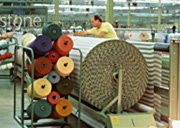| |

 Australian Breeds
Australian Breeds
A number of breeds have been developed and "fixed"
genetically by breeders in Australia and New Zealand.
Foremost of these are the Corriedale and Polwarth,
though the Perendale, Turidale and Drysdale are also
important - especially in New Zealand where they were
first produced.
 Corriedale
Corriedale
This is the main "dual purpose" breed, capable of
producing a second fleece of "Comeback" wool (i.e.
coarser than, but coming back towards, the merino
style) and at the same time having the ability to
produce an acceptable meat sheep carcass.
This breed was produced by crossing the Lincoln and
Merino and then carefully selecting the progeny to
fix a desirable type. The Corriedale was developed
simultaneously in New Zealand and Australia and is
now one of the world's most successful dual purpose
breeds. It is found in significant numbers in Australia
and New Zealand as well as South America, the USA,
South Africa, India and parts of Asia.
In Australia it is mainly raised in the higher rainfall
areas where it is more tolerant of prolonged periods
of wet weather than the Merino.
In external appearance the Corriedale is a large framed,
hornless sheep, with dark pigmented skin on nostrils
and lips and a heavy fleece of long stapled, bulky
wool.
Polwarth
This breed was developed in Victoria by starting with
a Lincoln/Merino first cross, and then crossing back
the Merino again. As such the Polwarth is three quarters
Merino and displays many of the same visual characteristics.
It does not have horns.
This breed also is sought for its ability to thrive
in areas considered too wet for the Merino, and produces
a long stapled fleece of approximately the same fibre
diameter as the strongest wooled Merinos.
Some Polwarths are to be found in New Zealand and
South America, but they are principally confined to
Southern Australia and in particular Tasmania and
Victoria.
 British Breeds
British Breeds
There are a larger number of breeds which came to
this country from England and are used primarily in
the production of sheep meats. These can be categorised
into the "longwool" types (such as the Border Leicester)
and the "Downs" or "shortwool" breeds such as the
Southdown and Dorset Horn. The commercially important
among these breeds are discussed below.
It is worth noting, however, that some of the breeds
that have little commercial significance today have
contributed greatly to the development of Australia's
sheep industry.
In particular, the English Leicester and Lincoln were
prominent in early flocks and played an important
role in the overall development of Australian sheep
and wool.
 Border Leicester
Border Leicester
This breed had its origins in the Border regions between
England and Scotland and first came to Australia in
the 1870s. Their principal use is to cross with the
Merino ewes for production of Border Leicester/Merino
ewes which in turn are mated to Downs breed rams to
produce prime lambs.
They are large, robust hornless sheep, with no wool
on face or legs. Their wool tends to be very long
and, by Australian standards, very coarse.
 Romney
Romney
Through this is the premiere breed in New Zealand,
and is the cornerstone of their prime lamb industry,
the Romney is little seen in this country.
In recent times, however, there has been an increasing
interest in the production of carpet wools in Australia,
and the Romney has an important role in that specialist
field.
 Poll Dorset
Poll Dorset
This breed was developed in Australia by breeders
who sought to retain the desirable characteristics
of the Dorset Horn, but wished to eliminate that breed's
horns, which presented significant management and
husbandry problems.
The Poll Dorset is now the most commonly used sire
in the production of prime lambs. Its main distinguishing
features are its hornless appearance, long square
body set on short legs, and 'spongy' short-stapled
wool.
 Southdown
Southdown
Perhaps the smallest of our sheep breeds, the Southdown
has an important role in the production of prime quality
sheep meats. When mated to Border/Merino ewes the
resultant lambs have the ability to very quickly reach
a marketable weight. They are especially prized by
breeders seeking to market their lambs in the early
'spring lamb' market, as this often provides a premium
price.
The distingushing features of the Southdown are its
short square head of almost 'piggish' appearance,
very square and long body, and extremely short legs.
The wool is quite short and spongy.
 Dorset Horn
Dorset Horn
These sheep are characterised by their very square,
chunky appearance and long body, and especially by
their massive horns, on both rams and ewes. They are
important commercially for their ability to pass to
their progeny their superior carcass composition and
their ability to grow very rapidly.
 Carpet Wool Breed
Carpet Wool Breed
wool carpets are made from the very coarsest wools
and until recently little or no wool of this type
was produced in Australia. New Zealand, however, is
a large producer of carpet wool, as their sheep industry
is primarily based on the coarse woolled Romney.
In Australia two new breeds of sheep are beginning
to attract a following for their ability to produce
carpet type wools. These are the Tukidale and Drysdale,
both genetic mutations or 'sports' derived from the
New Zealand Romney. Both types are stocky in appearance
and produce an extremely long stapled fleece of very
coarse wool.
 Others
Others
A number of other breeds are found in Australia, but
at present are of little commercial importance. These
breeds would include:
Longwools: Lincoln, Cheviot, English Leicester
Shortwools: Shropshire, Suffolk, South Suffolk, Ryeland,
Hampshire Down, Wiltshire Horn
|
 |
| |
 |
|